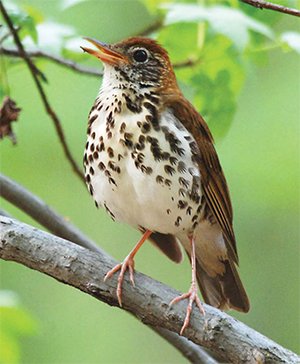Religion Professor Mark Wallace Reflects on Crum Woods

Tikkun: A Beaked and Feathered God: Rediscovering Christian Animism
Today the wood thrush returned to the Crum Woods. I have been waiting for this event for months. I first heard the thrush’s strange and wonderful birdcall three years ago, when I moved to a house in the woods outside Philadelphia. My friend Adrienne announced, “That’s the thrush! It’s back.” She explained that the thrush, while wintering in Mexico and Central America, spends the rest of the year in the eastern United States eating grubs, raising its young, and singing its beautiful song.
The song of the wood thrush is unlike anything else I have ever heard—liquid, flute-like, and perfectly pitched. The thrush vocalizes a kind of duet with itself in which it simultaneously produces two independent musical notes that reverberate with each other. To me it sounds like throat singing, the vocal technique that Tibetan monks use to sing two notes at the same time—a baseline and a melody line in contrapuntal balance—by amplifying their harmonic overtones. So I think of the wood thrush of the monk of the forest.
In the spring and summer I wake up, and often go to sleep, to the vocal pleasures of a bird that I cannot see, but I know that — like God’s Spirit — the thrush is there. I hear its lilt-ing cadence from dawn to dusk, but I’ve seen only one wood thrush during the time I’ve lived in the Crum Woods. I creep around the forest floor looking skyward, hoping for a sight-ing, but the wood thrush always escapes my gaze. Instead, I keep my window open at night as a vector for the thrush’s call. Bathed in its music, I find it hard to distinguish between waking and sleeping, between twilight, midnight, and early morning.
Thrushes prefer just the right habitat blend for sustenance and breeding: running water, dense underbrush, and moist soil full of fruiting plants and insects to eat. Like other neo-tropical songbirds, it is threatened by habitat loss through continued development of its home range. It is also endan-gered by brood parasites, such as brown- headed cowbirds, which lay their own eggs in wood thrush nests, crowding out the host’s eggs and hatchlings. The perdurance of the thrush in the face of these obstacles gives me hope in a time of despair about the world’s future.
Thoreau wrote in his journal that whoever hears the song of the wood thrush enters a “new world” where the “gates of heaven are not shut against” the listener. For me, the earth comes alive with mystery and wonder when I hear this bird’s ethereal song. In my own particular bioregion, the thrush opens to me the beauty of the Crum Woods as a vital habitat—indeed, as a sacred forest—whenever I am graced by its haunting polyphony.
Professor of Religion Mark Wallace is the author of Finding God in the Singing River: Christianity, Spirit, Nature (Fortress, 2005), Fragments of the Spirit: Nature, Violence, and the Renewal of Creation (Continuum, 1996; Trinity, 2002), and The Second Naïveté: Barth, Ricoeur, and the New Yale Theology (Mercer University Press, 1990, 1995). He received a 2003-04 Andrew W. Mellon New Directions for Scholars-Teachers Fellowship, which allowed him to initiate community-based learning into his Religion, the Environment, and Contemplative Practice course and forge an ongoing partnership between his classes and several community organizations in Chester, Pa.


